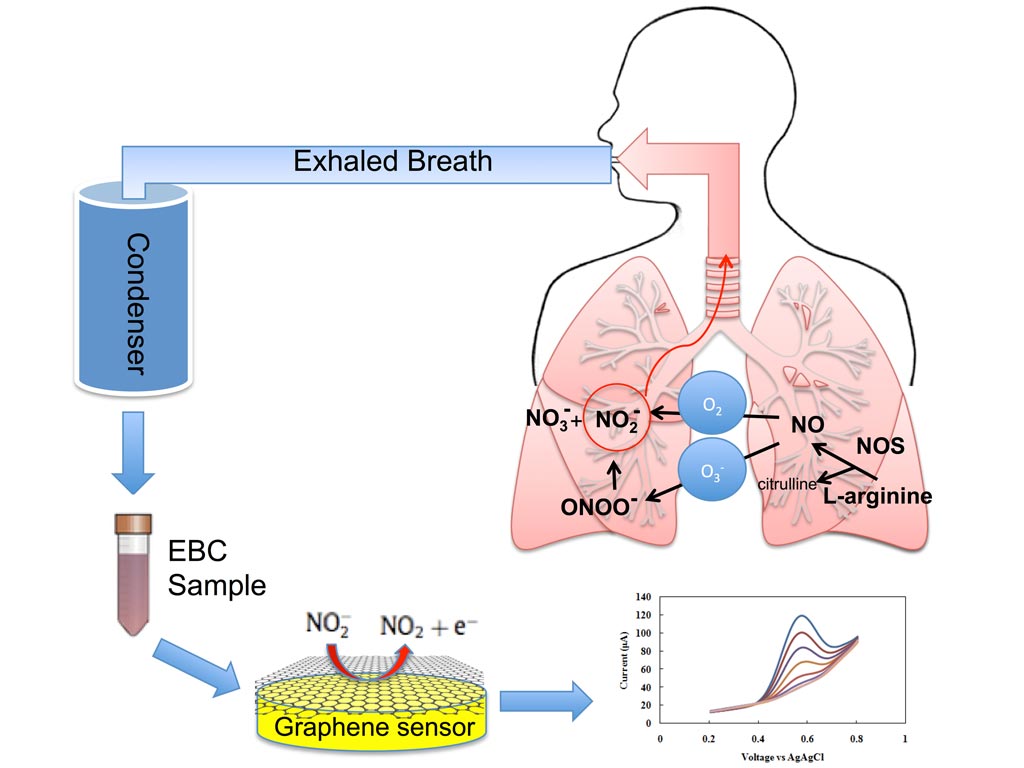Graphene-Based Sensor Helps Predict Asthma Attacks
By LabMedica International staff writers
Posted on 05 Jun 2017
Researchers have developed a prototype graphene-based device that detects inflammation in lungs, which could lead to earlier detection of asthma attacks and improve the management of asthma and other respiratory diseases, preventing hospitalizations and deaths. The invention helps pave the way for developing small wearable devices that could indicate when and at what dosage to take medication.Posted on 05 Jun 2017
A diverse team of experts at Rutgers University-New Brunswick (New Brunswick, NJ, USA) created the sensor in response to the need for improved, minimally invasive methods for the molecular diagnosis and monitoring of asthma. Today’s non-invasive methods are limited in characterizing the nature and degree of airway inflammation, and require costly, bulky equipment that patients cannot easily keep with them. The methods include spirometry, which measures breathing capacity, and testing for exhaled nitric oxide, an indicator of airway inflammation.

Image: Exhaled breath condensate is rapidly analyzed by a new graphene-based nanoelectronic sensor that detects nitrite, a key inflammatory marker in the inner lining of the respiratory airway (Photo courtesy of Azam Gholizadeh, Rutgers University).
Asthma causes inflammation of the airway and obstructs airflow. Other serious lung ailments include chronic obstructive pulmonary disease (COPD), which encompasses emphysema and chronic bronchitis.
“Our vision is to develop a device that someone with asthma or another respiratory disease can wear around their neck or on their wrist and blow into it periodically to predict the onset of an asthma attack or other problems,” said Mehdi Javanmard, assistant professor at Rutgers, “It advances the field of personalized and precision medicine.” Measuring biomarkers in exhaled breath condensate (tiny liquid droplets discharged during breathing) can also contribute to understanding asthma at the molecular level and lead to targeted treatment and better disease management.
Graphene is a thin layer of the graphite used in pencils. The new miniaturized electrochemical sensor accurately measures nitrite in exhaled breath condensate using reduced graphene oxide, which resists corrosion, has superior electrical properties, and is very accurate in detecting biomarkers.
“Nitrite level in breath condensate is a promising biomarker for inflammation in the respiratory tract. Having a rapid, easy method to measure it can help an asthmatic determine if air pollutants are affecting them so they can better manage use of medication and physical activity,” said Clifford Weisel, study co-author and professor at Rutgers, “It could also be used in a physician’s office and emergency departments to monitor the effectiveness of various anti-inflammatory drugs to optimize treatment.”
“Increases in airway inflammation may be an early warning sign of increased risk of an asthma attack or exacerbation of COPD, allowing for earlier and more-effective preventive measures or treatment,” said Robert Laumbach, study co-author and an occupational and environmental medicine physician at Rutgers.
“Just looking at coughing, wheezing, and other outward symptoms, diagnosis accuracy is often poor,” said Prof. Javanmard, “The ability to perform label-free quantification of nitrite content in exhaled breath condensate in a single step without any sample pre-treatment resolves a key bottleneck to enabling portable asthma management.” The next step is to develop a portable, wearable system. The researchers also envision expanding the number of inflammation biomarkers a device could detect and measure.
The study, by Gholizadeh A et al, was published May 22, 2017, in the journal Microsystems & Nanoengineering.
Related Links
Rutgers University-New Brunswick













